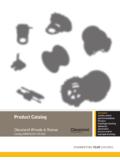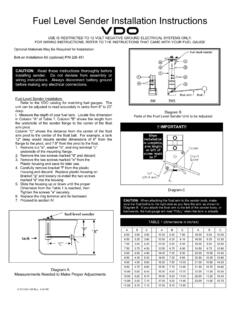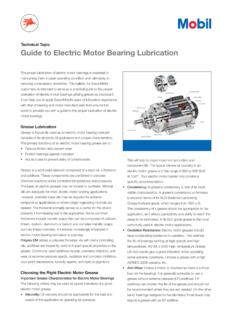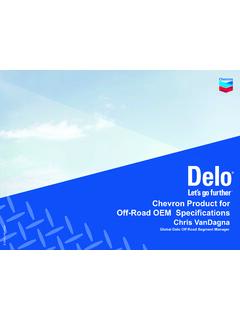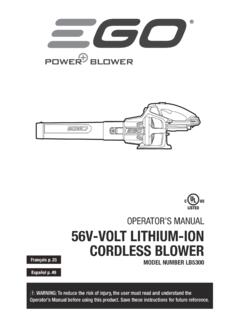Transcription of AEROSHELL GREASE TDS | Aircraft Spruce
1 GREASESAEROSHELL GREASESTHE DEFINITION OF A GREASE IS: A solid or semi-solid lubricant comprising a dispersion of a thickening agent in a liquid lubricant to which various additives have been added to improve particular properties .Within the aviation industry, there are many GREASE lubricated applications covering a very wide range of performance requirements. Those requirements are being increasingly stretched through new technology developments and extended service different GREASE formulations have been developed to meet specific requirements. One of Shell s recent objectives, as a major supplier of aviation greases, has been the development of wide performance range products where a single GREASE can cover a multitude of , depending on the thickening agent, are broadly classified as either soap-based or non-soap-based. The soap-based greases include, for example, aluminum, calcium, sodium or lithium soaps; the non-soaps silica gel, clay and substituted low melting points and water solubility of some soap greases limit their usefulness.
2 As a result alternative thickening agents have been developed soap-complex thickened greases, and non-soap greases with a much higher or no melting point. These thickening agents were developed for greases needing superior high temperature performance characteristics. Shell s search for thickeners without the limitations of the simple soap-type, led to a family of proprietary technologies including our Microgel and lithium -Complex greases rely on an inorganic GREASE thickening agent, based on hectorite clay, which has several advantages over simple soap-type thickeners. It provides the AEROSHELL greases in which it is used with excellent physical properties, as shown below. Those properties make them particularly suitable for multi-purpose as well as specialised applications. 1. No melting point, within any conceivable temperature range for Aircraft Very little change in consistency with variation in Extremely good load carrying ability without the need for extreme pressure Excellent water resistance due to the use of tenacious waterproofing agents developed by Low oil separation or bleeding , because of the high gelling recent years, the number of greases required for Aircraft lubrication/maintenance has been reduced by more extensive use of multi-purpose greases.
3 However, because of commercial and technological limitations, special greases are still required. Most Aircraft GREASE requirements are covered by the products in the AEROSHELL GREASE minimise the number of greases required per Aircraft , the most widely used specification in the aviation industry today is the general purpose GREASE to the early 2000 s the Boeing Company introduced a multi-purpose GREASE specification (BMS 3-33) to replace many of the different greases previously required in support of Boeing Aircraft . This has led to the development of the accompanying specification SAE AMS 3052. The only GREASE to meet the most challenging set of requirements of the initial BMS 3-33A specification has been AEROSHELL GREASE 33. This ground breaking GREASE , based on a lithium -Complex thickener system, has a superior capacity to accommodate a wide range of proprietary performance additives. This thickener system now forms the basis for future GREASE developments in the AEROSHELL GREASE information for each AEROSHELL GREASE is given in this section, but for ease of reference AEROSHELL greases can be split into the following application MULTI-PURPOSE GREASES (Wide temperature range with good load carrying properties) AEROSHELL GREASE 7 AEROSHELL GREASE 22 AEROSHELL GREASE 33 AEROSHELL GREASE 58 AEROSHELL GREASE 64 AEROSHELL GREASE 7 has a useful operating temperature range of 73 C to +149 C.
4 This coupled with its good load carrying ability make it entirely suitable for multi-purpose applications in Aircraft GREASE 22 is recommended for most aviation anti-friction bearing applications. It is especially recommended for use wherever severe operating conditions are encountered as in high bearing loads, high speed, wide operating temperature range, and particularly where long GREASE retention and high resistance to water washout are required. AEROSHELL GREASE 33 has a useful temperature range of 73 C to +121 C and is suitable for the majority of airframe GREASE GREASE 64, based on AEROSHELL 33, contains molybdenum disulphide and is particularly effective for lubricating heavily loaded sliding steel CARRYING GREASES Typical mean Hertz load (kg) AEROSHELL GREASE 7 60 AEROSHELL GREASE 22 39 AEROSHELL GREASE 33 60 AEROSHELL GREASE 58 79 AEROSHELL GREASE 64 Greases 7, 22, 33, 58 and 64 are suitable for operating under heavy load, gearboxes, retracting screws, worms, chains, and undercarriage pivot bearings.
5 TEMPERATURE GREASES Useful operating temperature range AEROSHELL GREASE 7 73 to +149 C AEROSHELL GREASE 15 73 to +232 C AEROSHELL GREASE 22 65 to +204 C AEROSHELL GREASE 33 73 to +121 C AEROSHELL GREASE 58 54 to +175 C AEROSHELL GREASE 64 73 to +121 CAeroShell GREASE 15 is suitable for use in lightly loaded ball and roller bearings throughout the temperature range TEMPERATURE GREASES WHICH HAVE GOOD LOAD CARRYING ABILITY Useful maximum temperature AEROSHELL GREASE 5 +177 C AEROSHELL GREASE 7 +149 C AEROSHELL GREASE 22 +204 C AEROSHELL GREASE 58 +175 C AEROSHELL GREASE 64 +121 CAeroShell GREASE 5 is recommended for normal high temperature applications when low temperature properties are not required; it has proved to be an excellent wheel bearing WITH ENHANCED CORROSION INHIBITION AEROSHELL GREASE 33 AEROSHELL GREASE 64 - (with 5% molybdenum disulphide) AEROSHELL GREASE 33 has enhanced corrosion resistance, and resistance to washout from water, de-icing fluids and other maintenance GREASE 64 is not subject to any speed restrictions and is widely accepted as an advanced multi-purpose PURPOSE GREASES WHICH HAVE A LIMITED OPERATING TEMPERATURE RANGE AEROSHELL GREASE 6 AEROSHELL GREASE 14 AEROSHELL GREASE 6 has a useful temperature range of 40 C to +121 C, good load carrying ability and is inexpensive, which makes it suitable for use as a general GREASE for piston engined GREASE 14 is now the universally accepted helicopter GREASE with a useful operating temperature range of 54 C to +94 C.
6 Owing to it s excellent anti-fret properties it is especially recommended for the lubrication of helicopter main and tail rotor GREASES AEROSHELL GREASE 14 Apart from its general purpose application for helicopters AEROSHELL GREASE 14 is also recommended when anti-fret and anti-corrosion properties are required, OF BASE OILSM ineral AEROSHELL GREASE 5 AEROSHELL GREASE 6 AEROSHELL GREASE 14 Synthetic HydrocarbonAeroShell GREASE 22 AEROSHELL GREASE 58 Synthetic EsterAeroShell GREASE 7 Silicone Oil AEROSHELL GREASE 15 Mixed Synthetic Hydrocarbon and EsterAeroShell GREASE 33 AEROSHELL GREASE 64 TYPES OF THICKENERM icrogelAeroShell GREASE 5 AEROSHELL GREASE 6 AEROSHELL GREASE 7 AEROSHELL GREASE 22 lithium ComplexAeroShell GREASE 33 AEROSHELL GREASE 58 AEROSHELL GREASE 64 Calcium SoapAeroShell GREASE 14 GENERAL COMMENTSGREASESAEROSHELL an Aircraft is certified, all of the greases are specified for each application point on the type certificate.
7 The Type Certificate will specify, either by specification number or by specific brand names, those greases which are qualified to be used. The Federal Aviation Administration (FAA) regulations state that only greases qualified for specific applications can be used in certified Aircraft . Therefore, it is the responsibility of the Aircraft owner or designated representative to determine which greases should be REQUIREMENTSThe majority of aviation GREASE specifications call for greases to be evaluated in the following tests:- Drop point- Penetration at 25 C, unworked/worked- Evaporation loss in 22 hours (temperature varies according to specification)- Corrosion, copper strip at 100 C- Water resistance at 40 C- Anti-friction bearing performance (temperature varies according to specification)- Mean Hertz load- Oil separation in 30 hours (temperature varies according to specification)- Bomb oxidation pressure drop (conditions vary according to specification).
8 In addition most aviation GREASE specifications call up other tests which are either specific to the type of GREASE or to the intended PROPERTIESIn the following section typical properties are quoted for each GREASE ; there may be deviations from the typical figures given but test figures will fall within the specification requirements. Due to poor repeatability of the low temperature torque test, typical test figures for this have not been OIL VISCOSITYA lthough not normally part of the specification requirements, typical base oil viscosities have been quoted for the majority of AEROSHELL OPERATING TEMPERATURE RANGEThe useful operating temperature ranges are quoted for guidance only. Continuous operation of equipment, with bearing temperatures at or in excess of these maximum and minimum limits for the grade in use, is not SEPARATIONOil separation to a greater or lesser extent occurs with all greases. Unless the separation is excessive the GREASE can be used providing it is stirred well before WITH MATERIALSWhen using greases containing a synthetic oil, particularly an ester oil, the compatibility with sealing materials, plastics or paints has to be with a silicone oil base should not be used when silicone elastomers are a general rule Shell Companies do not make recommendations regarding compatibility since aviation applications are critical and the degree of compatibility depends on the operating conditions, performance requirements, and the exact composition of materials.
9 In many cases the equipment manufacturers perform their own compatibility testing or have their elastomer supplier do it for them. Many elastomer suppliers do produce tables showing the compatibility of their products with a range of other materials. Therefore the information provided can only be considered as Rating:Very Good - Good - Fair - Poor - Very PoorElastomer/Plastic Mineral Oil Based Synthetic Synthetic Ester Greases Hydrocarbon Based Greases Based GreasesFlurocarbon (Viton) Very Good Very Good Very GoodAcylonitrile Good Good Poor to Good (high nitrile content is better)Polyester Good Good Poor to FairSilicone Poor to Good Poor to Good Poor to FairTeflon Very Good Very Good Very GoodNylon Poor to Good Poor to Good PoorBuna-S Poor Poor PoorPerbunan Good Good Fair to GoodMethacrylate Good Good Poor to FairNeoprene Fair to Good Fair to Good PoorNatural Rubber Poor to Fair Poor to Fair PoorPolyethylene Good Good GoodButyl Rubber Very Poor to Poor Very Poor to Poor Poor to FairPoly Vinyl Chloride Poor to Good Poor to Good PoorCOMPATIBILITY AND INTERMIXING OF GREASESWhat is GREASE incompatibility?
10 The National Lubricating GREASE Institute (NLGI) definition states that two greases show incompatibility when a mixture of the products shows physical properties or service performance which are markedly inferior to those of either of the greases before mixing. Performance or properties inferior to one of the products and superior to the other may be due to simple mixing and would not be considered as evidence of incompatibility; this is sometimes referred to as performance dilution .In general, mixing of greases made with different thickener types should be avoided; thus Microgel or clay thickened greases should not be mixed with soap thickened ( lithium complex) greases as this can lead to breakdown of the thickener structure. Incompatibility between greases can also arise from additive interactions. In some cases, different greases approved to the same specification may be incompatible with each other; to account for this, the MIL-PRF-23827C specification was amended to divide approved greases into Type I (soap-based) and Type II (clay-based).
